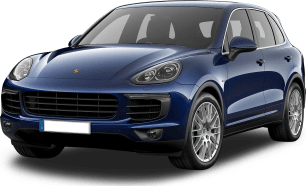The new Cayenne sits on the VW Group MLB Evo platform, which also underpins the Audi Q7, Bentley Bentayga, Lamborghini Urus, and the soon-to-arrive new generation VW Touareg.
It uses a lot of aluminium and lightweight high-strength steel which, in concert with the alloy body panels, makes the car not only stiffer, but lighter by up to 65kg.
We've driven each model over a two-day launch program in The Barossa Valley in South Australia, and can confirm the base Cayenne is quick, the S is properly fast, and the Turbo is ballistic.
The transmission is a conventional eight-speed auto, rather than Porsche's PDK dual-clutch, and shifts are quick but smooth in normal mode, transitioning to a sharper, even more precise response in Sport or Sport Plus.
Porsche stands proudly on its reputation as a great sports car maker and says the Cayenne fits easily into that context. But let's face it, this is a two tonne SUV, and while it's dynamically outstanding, it's no 911.
All models feature multi-link suspension front and rear including active dampers, with varying levels of suspension sophistication as you walk up the range, to three chamber air suspension on the Turbo.
On quick twisting B-roads it's fast, in the case of the Turbo, bloody fast. It grips hard thanks to fat Z-rated rubber and active drive distribution makes sure it puts its power down perfectly. But no matter how sophisticated the suspension tech, it still feels large and relatively top heavy.
The electromechanical steering is light, and while it's accurate, no matter which mode you're in road feel is modest.
Not surprisingly, the ride firms up in tune with sportier drive modes, but in Comfort, even the Turbo on 21-inch rims, soaked up the irregularities of at times choppy rural roads with surprising ease.
Given the car's mass and performance potential braking is an understandable priority, with even the base model featuring big ventilated rotors all around with four piston calipers at the front and two at the back.
The S ups that to six piston front and four at the rear, while the Turbo debuts Porsche's 'Surface Coated Brake' a Tungsten-Carbide coating on the discs and special pads for longer life and less dust. Of course, the front calipers are 10-piston with four at the rear (and they're white just to prove brake dust isn't a problem).
In typical Aussie conditions these monster brakes are like cracking a walnut with a sledgehammer. Stopping power (on all models) is immense, and pedal feel is agreeably progressive.
We also headed off-road through rutted dirt and rocky climbs, and with five drive and chassis modes at its disposal the Cayenne ate it up.
The different off-highway modes ('Gravel', 'Mud' and 'Rock') will lock and unlock the centre and rear diff as required and the adjustable hill descent control made crawling down steep slopes a breeze. You can even option up an 'Offroad Package' bringing extra protection for vital components, as well as off-road specific info in the PCM and a compass display on the dash.
If you need to think about the dips and climbs on your country retreat, or maybe just the pitch of your driveway, the Cayenne and Cayenne S's approach and (with the Turbo in brackets) is 25.2degrees (23.3), ramp over is 18.7degrees (16.7), departure is 22.1degrees (20.4), ground clearance measures 210mm (190mm), and fording depth is 500mm (475mm).






